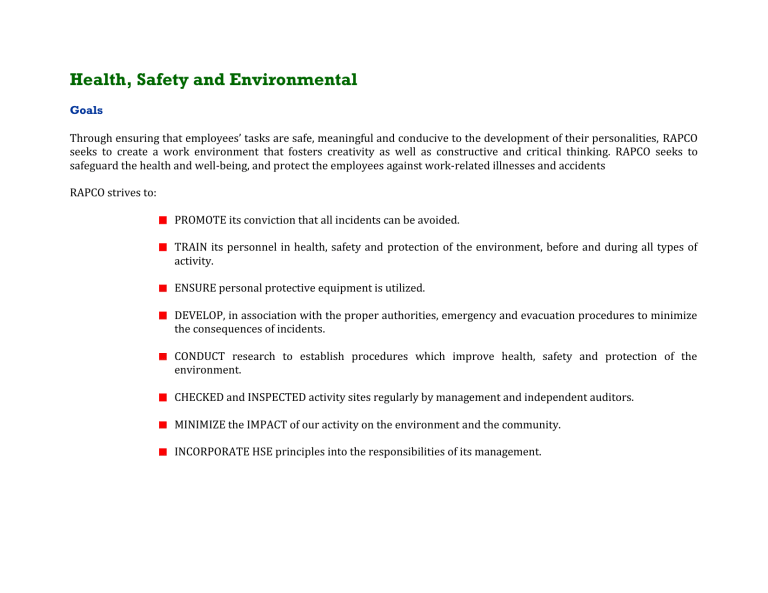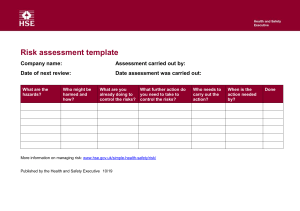
Health, Safety and Environmental Goals Through ensuring that employees’ tasks are safe, meaningful and conducive to the development of their personalities, RAPCO seeks to create a work environment that fosters creativity as well as constructive and critical thinking. RAPCO seeks to safeguard the health and well-being, and protect the employees against work-related illnesses and accidents RAPCO strives to: PROMOTE its conviction that all incidents can be avoided. TRAIN its personnel in health, safety and protection of the environment, before and during all types of activity. ENSURE personal protective equipment is utilized. DEVELOP, in association with the proper authorities, emergency and evacuation procedures to minimize the consequences of incidents. CONDUCT research to establish procedures which improve health, safety and protection of the environment. CHECKED and INSPECTED activity sites regularly by management and independent auditors. MINIMIZE the IMPACT of our activity on the environment and the community. INCORPORATE HSE principles into the responsibilities of its management. The health, safety and environmental (HSE) work at RAPCO shall constitute continuous and systematic efforts that are integrated into the primary activities. Health, Safety and Environmental Policy RAPCO is dedicated to maintaining the environment in which it works and providing a safe and healthy workplace for employees and contractors through the active implementation of comprehensive policies and programs. RAPCO defines safe operating procedures by utilizing industry-wide "best operating practices" that are designed to meet, or exceed, all appropriate legal requirements. A high level of safety awareness is maintained by means of safety meetings, training, internal auditing, and general communications. All employees are actively obligated to participate in the conduct and management of safety through achieving defined objectives and standards, which are regularly reviewed and appraised. It is the responsibility of all line managers to ensure that employees and sub-contractors are aware of, and have access to copies of, all legislative requirements, company policies and procedures in addition to seeing that these are duly enforced. Line management ensures that individuals are provided with proper and appropriate training along with sufficient and suitable means in order to comply with these requirements. All employees are required to become familiar with, adhere to and promote the company policies throughout all aspects of their duties. In addition, each individual shall have the opportunity to suggest changes and improvements by means of internal communications directly to a nominated company representative. Risks are minimized by investigating incidents to determine their root causes and to determine corrective actions, which shall prevent recurrence. These investigations and root causes are documented, circulated company-wide and followed up to ensure completion. RAPCO GROUP Trading, Contracting, and Industrial Constructions EPC CONSTRUCTOR P.O. BOX: 759, RAS TANURA 31941 – KSA TEL. NO. (03) 668 1617/1514 – 667 2219 FAX NO. (03) 668 1564 WEBSITE: www.rapcogroups.com MONTHLY HSE REPORT Project ___________________________________ Site ___________________________________ Month ___________________________________ Number of Incidents Total No. of Incidents Total No. of Occupational Injury Lost Time Incident Environment Material Fires & Explosion Other Production loss New cases of Occupational Illness Lost Workdays due Total working hours in construction Date: Signature RAPCO GROUP Trading, Contracting, and Industrial Constructions EPC CONSTRUCTOR P.O. BOX: 759, RAS TANURA 31941 – KSA TEL. NO. (03) 668 1617/1514 – 667 2219 FAX NO. (03) 668 1564 WEBSITE: www.rapcogroups.com ENVIRONMENTAL POLICY RAPCO recognizes that day-to-day operations can impact both directly and indirectly on the environment. We aim to protect and improve the environment through good management and by adopting best practice wherever possible. RAPCO is committed to minimize the impact of its activities on the environment; achieving environmental excellence in both, it’s corporate operations and the services it renders to its clients. The key points of its strategy to achieve this are: Minimize waste by evaluating operations and ensuring they are as efficient as possible. Minimize toxic emissions through the selection and use of its fleet and the source of its power requirement. Actively promote recycling both internally and amongst its customers and suppliers. Source and promote a product range to minimize the environmental impact of both production and distribution. Meet or exceed all the environmental legislation that relates to the Company. Use an accredited program to offset the greenhouse gas emissions generated by our activities. Establish targets to measure the continuous improvement in our environmental performance. Involve customers, partners, clients, suppliers and subcontractors in the implementation of our objectives. RAPCO GROUP Trading, Contracting, and Industrial Constructions EPC CONSTRUCTOR P.O. BOX: 759, RAS TANURA 31941 – KSA TEL. NO. (03) 668 1617/1514 – 667 2219 FAX NO. (03) 668 1564 WEBSITE: www.rapcogroups.com – Index – Environmental Management System Manual Introduction and Core Elements Environmental Policy Structure and Responsibility Environmental Objectives and Targets and Associated Management Program Training Strategy (Awareness and Competence) Internal EMS Audit Schedule HSE Objectives and Targets 1. APPLICABILITY This standard applies to all RAPCO GROUP trading and services it renders to its clients 2. OVERVIEW HSE Management Systems are designed to maintain HSE excellence and facilitate continual improvement by creating a cycle of activities, including aspects identification and prioritization, performance measurements, self-assessments and audits. This cycle of activity will identify the current and most critical HSE issues for an organization. The establishment of objectives and targets that address those issues will effectively and continually reduce the organization's significant risks. This standard provides the guidance and requirements to help set objectives and targets that address the significant HSE issues facing an organization. 3. DEFINITIONS Contractors Objectives 4. REQUIREMENTS Any non-RAPCO employee doing work for RAPCO, whether on or off RAPCO 's property, and includes, but is not limited to, subcontract workers, consultants, individuals performing onsite contract services and individuals performing off-site outsource services Strategic, usually long term, HSE goals that are designed to address the organization's most significant and prioritized HSE aspects. Objectives should align with both the RAPCO HSE policy and the organization's strategic plan 4.1 Documented HSE objectives and targets must be established and integrated into the organization’s business planning process. 4.2 The prioritization process must include the following information: 4.2.1 Commitments and values of the RAPCO HSE Policy 4.2.2 Significant aspects analysis identified through the organization’s Aspects and Impacts assessment 4.2.3 Available and feasible technological options 4.2.4 Financial, operational and business requirements of the organization 4.3 Organization HSE objectives must be established for all HSE issues determined to be priorities through the prioritization process described in section 4.2 of this standard. 4.4 Targets, roles, responsibilities and descriptions for carrying out HSE objectives shall be documented and incorporated into the organization’s Management Plans 4.5 Time frames shall be assigned for all HSE objectives and targets. 4.6 HSE objectives and targets must be approved by the organization’s Senior Leadership 4.7 Performance toward achieving and continued appropriateness of HSE objectives and targets must be reviewed and updated by Senior Leadership: 4.7.1 As part of the organization's normal performance review process and Monitoring and Measurement & Self-Assessment 4.7.2 Following any regulatory or operational change that has the potential to introduce new requirements, hazards or risks to the organization 4.7.3 As a minimum annually 4.8 Objectives and targets must be communicated to all those responsible for achieving the objectives including employees, contractors and organization management. 4.9 Records 4.9.1 All objectives and targets shall be documented. At a minimum, the documentation shall include: 4.9.2 Results of the organization's prioritization process 4.9.3 Names & titles of the team that developed the objectives and targets 4.9.4 Record(s) of the identified objectives and targets and the period over which they apply HSE Training 1. APPLICABILITY This standard applies to all RAPCO GROUP trading and services it renders to its clients. The requirements of this standard are applicable to all HSE training. 2. OVERVIEW The behavior of our employees and culture of our company are key factors in the success of RAPCO’s HSE Management System and overall HSE performance. Training is a fundamental and necessary method for shaping behaviors and developing our employees. An effective training program can inform employees of the HSE hazards and controls in the workplace, help them recognize and appropriately respond to hazardous situations and drive compliance to HSE rules and procedures established by the organization. Everyone with a role in RAPCO has a role in RAPCO’s HSE Management System. Therefore, some form of HSE training will be applicable and valuable to all. This standard assists RAPCO organizations in identifying those training needs, selecting the right training methods and delivering training in an effective and sustainable manner. 3. REQUIREMENTS 3.1 The organization shall conduct and document an HSE training needs assessment. 3.1.1 The training needs assessment shall be based on the organization's scope, aspects and impacts assessment, legal and other requirements assessment and training requirements derived from the organization's current or anticipated operational controls. 3.1.2 The training needs assessment shall identify: 3.1.2.1 Titles of the jobs or job classifications covered by the organization's scope, including RAPCO employees and non-RAPCO employees covered by the aspects and impacts assessment 3.1.2.2 Training programs required for each job or job classification 3.1.2.3 Training and testing frequency 3.1.3 The training needs assessment shall be reviewed at least annually and updated to reflect changes to the workplace, activities, equipment, processes, or procedures. 3.2 The organization shall ensure that training programs are established and implemented to meet the training needs assessment. 3.2.1 Training programs shall be developed and delivered in such a way that they result in desired performance, behaviors and comprehension by the intended audience. 3.2.1.1 Training programs shall be appropriate for the intended audience and adequately address organizational levels, risks, ability, literacy and language skills. 3.2.1.2 Where necessary to achieve the desired performance, training programs shall be specific to the workplace, activities or operations. 3.2.1.3 Where required by legal and other requirements or by RAPCO HSER Standards, the organization shall identify expected competency level and implement methods to assess competency as a result of the training. 3.2.2 Training programs shall be reviewed and updated to reflect changes to the workplace, activities, equipment, processes, or procedures. 3.3 The organization shall conduct training as identified in the training needs assessment. As a minimum, the following requirements shall be met: 3.3.1 Training on the HSE Management System, employee roles and responsibilities in the management system, and consequences for deviations from the management system 3.3.2 Hazards, risks and controls applicable to each job or job classification 3.3.3 Emergency awareness training to all employees and contractors (e.g. evacuation, relocation, shelter-in-place, etc.) and emergency response training for individuals with assigned response duties. 3.3.4 The organization shall assure that employees receive appropriate training prior to performing new tasks or beginning new work assignments. 3.3.5 Training programs shall include direction to resources capable of answering questions related to the training. 3.4 Records 3.4.1 The results of the HSE training needs assessment shall be documented. In addition to the items listed in section 3.1.2 of this standard, the documentation shall include: 3.4.1.1 The names of those that conducted the assessment 3.4.1.2 The date of the assessment 3.4.2 Documented records shall be maintained for all HSE training programs in accordance with Document and Records Management. As a minimum, the documentation shall include: 3.4.2.1 A description of the training subject, material and delivery method 4.4.2.2 If delivered by an individual, the name and qualifications of the trainer 4.4.2.3 Where required, the expected competency level necessary to successfully complete the training 3.4.3 HSE training records shall be established and maintained for the workforce: 4.4.3.1 The name(s) and job title who received the training 4.4.3.2 Name of the training program and the date the training was received. 4.4.3.3 Results of any competency assessments


